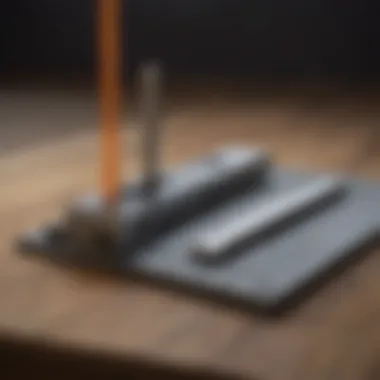Measuring a Square Foot: A Comprehensive Guide


Intro
Accurate measurements are foundational in various fields, particularly when it comes to real estate and interior design. Understanding how to measure a square foot effectively brings clarity to space planning and enhances the decision-making process. This guide will delve into the significant aspects of measuring a square foot, including definitions, practical techniques, and commonly overlooked details.
The square foot as a unit can sometimes lead to misconceptions, particularly regarding how to properly calculate or visualize it. This article aims to clarify these misunderstandings, empowering both novices and professionals alike to approach measurements with confidence.
Feature Spotlight
Exceptional Architectural Designs
In real estate, knowing the exact square footage of a property can influence its market value. For example, homes with open floor plans often utilize square footage differently than more traditionally designed spaces. Features such as vaulted ceilings and large windows add perceived space, even if not reflected in the square footage. Therefore, precise measurements are vital to assess the actual usable area versus the reported size.
In interior design, recognizing square footage can determine how to best arrange furniture or design layout flows. For example, a designer might emphasize the use of a 500 square foot living room by suggesting specific furniture arrangements that optimize that space while ensuring it feels both functional and appealing.
Unique Decor Elements
Searching for an accurate idea of square footage is not limited to walls and floors. When considering decor, every element matters. Different styles of furniture, color choices, and textures can create a perception of space. For instance, minimalist designs might require fewer square feet but can provide a spacious feel through careful arrangement and selection of decor elements. Knowing the exact square footage allows for more informed decisions when creating harmonious spaces with a coherent flow.
Techniques for Measuring a Square Foot
To effectively measure a square foot, certain methods and tools can enhance accuracy. Here are essential techniques:
- Using a Measuring Tape: Ensure the tape is long enough to measure larger areas. For smaller spaces, a standard 25-foot tape measure suffices.
- Laser Measurement Tools: These provide quick and precise measurements, ideal for larger spaces and can easily calculate square footage from length and width.
- Blueprints or Floor Plans: If available, these documents can often provide accurate square footage and dimensions, though one should always verify to ensure they match reality.
- Calculating Area: The formula for square footage is simple: multiply the length by the width. For example, a room that is 10 feet wide and 15 feet long has a total area of 150 square feet.
Applications in Real Estate
Understanding square footage influences several critical aspects in real estate. Not only does it impact pricing, but it also affects how properties are marketed and displayed. Buyers often look for square footage when assessing value. It can also influence the buyer's perception of livability and functionality of a space.
"Square footage can often make or break a sale in real estate, proving that accurate measurement is not merely a detail, but a key element in a successful transaction."
Common Misconceptions
There are a few frequent misunderstandings regarding square footage that should be clarified:
- Total Area Equals Usable Area: This is not always the case, as some measurements may include non-livable spaces such as walls or hallways.
- All Measurements are Accurate: Sometimes individuals may rely on advertised square footage without independently verifying it.
- Square Footage is Always Consistent: Depending on how homes are built and the methods used to calculate space can yield variances in square footage.
Epilogue
In summary, measuring a square foot accurately is integral across various fields, particularly real estate and design. As one becomes more familiar with measuring techniques and tools, they can enhance their proficiency in creating well-planned and thought-out spaces. Understanding the nuances surrounding square footage empowers professionals and enthusiasts to make informed decisions, ensuring that every inch is utilized effectively.
Understanding Square Foot Measurement
Understanding the concept of measuring a square foot is foundational for various fields, from real estate to interior design. This measurement allows professionals and enthusiasts alike to quantify space accurately, ensuring effective use and planning. In a world where space is often at a premium, knowing how to gauge square footage becomes critical.
Definition of a Square Foot
A square foot is a unit of area that is equivalent to the area of a square where each side measures one foot in length. To visualize, think of a square where each edge is twelve inches. This unit is commonly used in the United States for measuring properties, rooms, and various spaces. For those unfamiliar, square footage can be calculated using the formula:
Area = Length × Width
Thus, if a room is 10 feet long and 12 feet wide, the area would be 120 square feet (10 × 12). This mathematical simplicity aids in making quick and efficient calculations, making it essential knowledge in property evaluations.


Importance of Accuracy in Measurement
Accuracy in measuring square footage is paramount. Inaccurate measurements can lead to significant consequences in real estate transactions, renovations, and space planning. Importantly:
- Financial Implications: Miscalculation may inflate or deflate property values. A larger reported area may demand a higher sale price, while underestimations can lead to financial losses.
- Design Efficiency: Interior designers rely on precise measurements to create functional and aesthetic spaces. An inexact measurement can disrupt the design workflow, leading to costly adjustments later.
- Compliance with Regulations: Various building codes and ordinances require accurate measurements for safety and legal compliance. Failing to adhere to these requirements can lead to fines or delays in project completion.
In summary, the significance of square foot measurement extends beyond mere numbers. It influences economic value, design principles, and regulatory compliance. Mastering these concepts prepares individuals for informed decision-making in numerous fields.
Basic Calculation Techniques
Understanding measurement techniques is essential in achieving accurate square footage calculations. Correctly applying these methodologies not only assures valuable assessments in various fields like real estate and interior design, but also aids in informed decision-making. Familiarity with basic calculation techniques allows individuals to conduct their work with more confidence, leading to better outcomes.
Formula for Calculating Area
The area of a square foot is defined as 144 square inches or a space that measures one foot by one foot. The general formula to calculate an area for rectangular spaces is:
[ \textArea = \textLength \times \textWidth ]\
When calculating the area, it is important to ensure that both length and width are measured in feet. For instance, if a room measures 10 feet in length and 12 feet in width, the area calculation will be:
[ \textArea = 10 \text ft \times 12 \text ft = 120 \text square feet ]\
This formula serves as the foundation for many measurement tasks. Utilizing it accurately facilitates effective planning in various domains, ensuring that spaces are utilized efficiently.
Measuring Rectangular Spaces
When measuring rectangular areas, one only needs to use a tape measure or a laser distance measurer. It is crucial to take measurements at the most suitable points, ideally at the corners of the space. Ensure that devices are straight to avoid discrepancies.
- Start by measuring the length of the area.
- Next, measure the width at a right angle to the length.
- Apply the area formula to get the square footage.
It is advisable to record measurements as you go to prevent confusion later. Also, double-check the calculations for improved accuracy. Proper application of this technique not only enhances precision but also facilitates estimating costs for flooring, paint, and furniture placement.
Variations: Non-Rectangular Areas
Measuring non-rectangular areas, such as circular or irregularly shaped spaces, requires a more tailored approach. For circular areas, one can use the formula:
[ \textArea = \pi \times (\textRadius)^2 ]\
For example, if a circular garden has a radius of 5 feet, its area can be expressed as:
[ \textArea \approx 3.14 \times (5)^2 \approx 78.5 \text square feet ]\
In cases where spaces are more complex, breaking them down into simpler shapes like rectangles or triangles is useful. Calculate each section's area independently and sum them for the total square footage. Utilizing templates or graph paper can assist in visualizing the area efficiently.
"Understanding different area calculations enhances spatial awareness and supports practical development in real estate, design, and related fields."
Familiarity with these techniques provides valuable insights into the size and usability of any space.
Tools for Measuring
Understanding the tools for measuring is crucial for obtaining accurate square foot calculations. The right tools can provide not only precision but also ease and efficiency in measurement tasks. Two primary categories exist: traditional methods with tape measures and advanced techniques with laser distance measurers. Choosing the appropriate tool depends on various factors, such as the project size, space complexity, and user preference.
Tape Measures vs. Laser Distance Measurers


Tape measures are a tried-and-true method used since the advent of measuring practices. They offer several advantages, including:
- Simplicity: Easy to use, requiring no advanced technology.
- Portability: Lightweight and can fit in a pocket or toolbox.
- Versatility: Suitable for both small and large spaces, from measuring furniture to entire rooms.
However, tape measures have some limitations. They can be less accurate when measuring large distances, due to issues like sagging and manual errors. Long lengths may also make handling cumbersome.
In contrast, laser distance measurers have grown in popularity in recent years. They provide several benefits:
- Accuracy: Capable of measuring long distances with precision up to millimeters.
- Speed: Quickly jumps from point to point without needing physical manipulation of a tape.
- Features: Often include additional functions like area calculation, Pythagorean measurement, and memory storage.
On the downside, laser distance measurers can be more expensive and require power, either from batteries or a charge. While they may seem complex initially, their learning curve is shallow, and they streamline measuring tasks effectively.
Understanding Area Calculators
Area calculators serve as a supplemental tool in the measuring process. These calculators can assist in determining square footage from input dimensions. Understanding how to effectively use these calculators enhances not only accuracy but also ease in measurement. Here are some points to consider:
- User-Friendly Interfaces: Many calculators have straightforward interfaces, allowing users to input dimensions quickly.
- Variety of Shapes: They accommodate various geometric shapes, such as circles, triangles, and irregular polygons, simplifying complex area calculations.
- Instant Results: Once the dimensions are entered, the area is calculated instantly, saving substantial time.
Moreover, users can find both physical and digital area calculators:
- Physical Calculators: Handheld devices often provide reliable performance without needing an internet connection.
- Apps and Online Tools: Many smartphone applications and websites provide additional functionality and support for users.
Area calculators improve the reliability of measurements, helping avoid errors that may arise from manual calculations. They are essential for anyone requiring accurate square footage assessments in fields like real estate and interior design.
"Using the right tools for measuring can transform an arduous task into a simple and achievable one."
Practical Applications
The concept of square foot measurement extends beyond mere numbers; it has tangible implications across various domains. In real estate, precise area measurements influence property valuation and buyer decisions. Interior design relies on accurate assessments to enhance the functionality and aesthetics of spaces. Furthermore, proper measurement in landscaping can dictate the layout of outdoor areas, ensuring both beauty and utility. Each of these factors showcases the critical need for clear and reliable measurement techniques.
Application in Real Estate
In the realm of real estate, the significance of measuring a square foot cannot be overstated. Properties are typically valued based on their total square footage, affecting pricing strategies. Whether it's a cozy apartment or a sprawling estate, an accurate square footage calculation provides a baseline for understanding property worth.
- Buyers often compare the price per square foot to determine affordability.
- Real estate agents rely on these measurements for accurate listings.
- Misrepresentation of size can lead to legal issues; thus, precision is paramount.
Given the competitive nature of the market, real estate professionals must present exact figures. An appraisal process often includes a thorough measurement of the property to ascertain its actual area. This diligence ensures trust and transparency between buyers and sellers.
Interior Design Considerations
In the field of interior design, accurately measuring square footage is foundational. Designers use specific measurements to optimize space usage and create inviting layouts. In this discipline, knowing the square footage influences choices in furnishings, color schemes, and overall design flow.
- Effective space planning relies on understanding dimensions.
- Designers must account for functionality, aesthetics, and traffic flow, often dictated by the area available.
- Incorrect measurements can result in ill-fitting furniture or inefficient layouts, leading to a poor user experience.
Interior designers must utilize a range of tools and techniques, from standard tape measures to digital solutions, to ensure they have the correct measurements. With accurate square footage, they can create a cohesive and harmonious design that serves both beauty and function.
Landscaping and Outdoor Spaces
Square foot measurements are also crucial when it comes to landscaping and outdoor development. A well-designed garden or yard requires careful planning, often starting with a precise understanding of the area available. This clarity allows for effective allocation of resources and design elements.
- Knowing the total square footage helps in selecting appropriate plants that fit the space.
- Proper measurements ensure the layout accommodates walkways, patios, and other features seamlessly.
- Landscaping projects often involve zoning considerations; therefore, accurate measurements prevent issues related to property boundaries.
Properly measuring outdoor areas allows homeowners and professionals alike to create spaces that are both functional and visually pleasing. Whether planning a small flower bed or a large patio, the principles of square footage measurement guide the design and execution of landscaping projects.


Common Misconceptions
Misunderstanding square foot measurement often leads to errors that can have lasting implications, particularly in real estate and interior design. A clear comprehension of these misconceptions enhances not only the accuracy of measurements but also informs better decision-making in various contexts. Here, we will explore two common misconceptions that individuals may encounter: mistakes in area representation and confusion regarding units of measurement.
Mistakes in Area Representation
One prominent misperception stems from the belief that area is simply about dimension. This viewpoint can result in significant errors. For instance, some individuals measure their space only in linear terms, ignoring irregularities in shape. An example could be a room that is not entirely rectangular; if measurements focus merely on the longest sides, the resulting area will not accurately reflect the true size of the space.
To prevent such miscalculations, it is essential to consider every dimension of a room. Including recesses, alcoves, and other architectural features can lead to a more precise representation of area. Accurately designing spaces requires recognizing that every corner and edge contributes to the overall calculation. Additionally, not differentiating between usable space and total square footage can mislead stakeholders about a property’s value or potential.
"Always account for complexity in shapes when calculating area for reliable assessments."
Units of Measurement Confusion
Another area of misunderstanding involves the different units of measurement that can be used when quantifying square footage. Converting between metric and imperial units, for example, can lead to significant discrepancies if not done carefully. Many people might conflate square feet and square meters, leading to confusion when they inaccurately translate values between these two systems. Missing the distinction can affect not just dimensions but also financial evaluations tied to property size.
It is crucial to standardize units before making calculations. When engaging in projects that involve design and real estate, all stakeholders should agree on the units being used. Furthermore, understanding how to convert these units accurately will mitigate miscalculations effectively.
Regulatory Standards
Measuring a square foot is not solely a technical endeavor; it also embodies adherence to regulatory standards that govern land and building use. Understanding these standards is crucial for anyone involved in construction, real estate, or urban planning. Regulatory standards establish the parameters within which measurements must fit, ensuring safety, compliance, and uniformity in practices across different projects. Familiarity with these regulations can significantly impact project outcomes and property values, paving the way for successful ventures.
Building Codes and Regulations
Building codes are a set of rules that specify the minimum acceptable level of safety for constructed objects. They vary from region to region, reflecting local risks, available materials, and cultural practices. Each code includes guidelines on how measurements should be taken, particularly concerning square footage. The following aspects are important when dealing with building codes:
- Safety Standards: Complying with square foot measurements ensures that structures are built with stability and reliability.
- Permitting Process: Accurate measurements are essential for obtaining necessary permits. A miscalculation can result in permit denials or fines.
- Property Assessments: Local authorities often assess properties based on square footage for tax purposes. Incorrect measurements could lead to over or under-taxing.
In particular, the International Building Code (IBC), which many jurisdictions adopt, outlines specific regulations on what constitutes livable space. This includes definitions of finished floor areas, meanings of habitable space, and distinctions between gross and net square footage.
Zoning Laws Insights
Zoning laws dictate how land can be used in different areas and directly affect square footage calculations. Understanding these insights is vital for architects, developers, and homeowners. It provides clarity on limitations and allowances concerning property usage, which can profoundly influence design choices. Key considerations include:
- Setback Requirements: Zoning laws often specify how far structures must be from property lines. This can affect how much area can be built upon and measured.
- Use Restrictions: Different zones allow for various purposes. For instance, commercial zoning versus residential zoning presents unique square footage requirements.
- Density Regulations: Some zones impose limitations on how much square footage can be built on a specific plot, impacting how developers plan projects.
In summary, understanding regulatory standards surrounding square foot measurement fosters a clear path toward compliance for any real estate or construction endeavor. Without adherence to these guidelines, the risks associated with financial penalties, safety issues, and project delays increase significantly.
"Adhering to local building codes and zoning laws is not optional; it is fundamental to the integrity of any construction project."
By integrating these standards into measurement processes, individuals and organizations can safeguard their investments while contributing to community structure and safety.
Future of Measurement Techniques
The future of measurement techniques holds great significance in the realm of square foot measurement. As buildings grow more complex and sustainable design becomes critical, accurate measurements are essential. Advances in technology will enhance the precision of measurements and streamline the processes used in various fields, including real estate and interior design. The benefits of these innovations include time savings, improved accuracy, and the ability to adapt to changing design concepts.
Technological Innovations in Measuring
Technological advancements are rapidly transforming the way measurements are taken. One of the most critical innovations is the use of laser distance measuring devices. These devices are incredibly precise and can quickly gauge distances with minimal effort. They eliminate the need for traditional tape measures, providing instant readings that save time and reduce errors.
Additionally, mobile applications equipped with augmented reality capabilities enable users to visualize measurements in real-time. By overlaying digital measurements onto physical spaces, these tools simplify the measurement process, particularly in interior design scenarios. 3D scanning technology also offers a new level of accuracy and efficiency. Users can capture entire spaces and analyze dimensions within a digital environment, allowing for a comprehensive understanding of the area without several manual measurements.
Implications for Sustainable Design
The implications of advanced measurement techniques are particularly significant for sustainable design. Accurate measurements facilitate more efficient use of materials, which helps minimize waste. By ensuring that the right amount of materials is purchased, designers can contribute to environmentally responsible practices.
Furthermore, these innovations support energy-efficient building designs. Precise measurements allow architects and builders to plan spaces effectively, maximizing natural light and ventilation and reducing energy consumption. As green building standards become more stringent, the ability to measure accurately is directly tied to compliance and overall project success.
"In an era where sustainability is paramount, precise measurements amplify the effectiveness of various designs, contributing to greener living and building practices."







